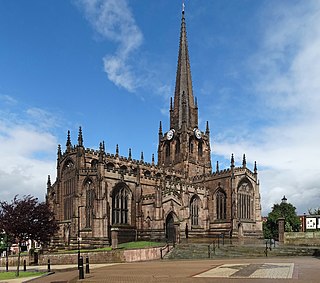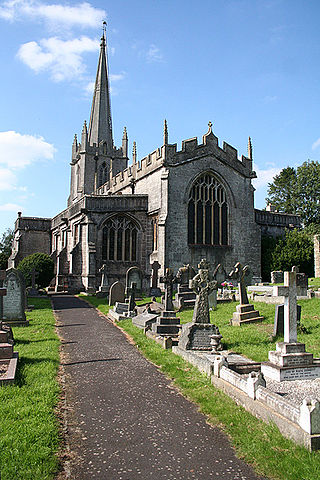
The Church of St Mary the Virgin, widely known as St Mary Redcliffe, is the main Church of England parish church for the Redcliffe district of the city of Bristol, England. The first reference to a church on the site appears in 1158, with the present building dating from 1185 to 1872. The church is considered one of the country's finest and largest parish churches as well as an outstanding example of English Gothic architecture. The church is so large it is sometimes mistaken for Bristol Cathedral by tourists. The building has Grade I listed status, the highest possible category, by Historic England.

The Cathedral of the Blessed Virgin Mary is a Church of England cathedral in the city of Truro, Cornwall. It was built between 1880 and 1910 to a Gothic Revival design by John Loughborough Pearson on the site of the parish church of St Mary. It is one of only three cathedrals in the United Kingdom featuring three spires.

Christ Church Greyfriars, also known as Christ Church Newgate Street, was a church in Newgate Street, opposite St Paul's Cathedral in the City of London. Established as a monastic church in the thirteenth century, it became a parish church after the Dissolution of the Monasteries. Following its destruction in the Great Fire of London of 1666, it was rebuilt to the designs of Sir Christopher Wren. Except for the tower, the church was largely destroyed by bombing during the Second World War. The decision was made not to rebuild the church; the ruins are now a public garden.

Christ Church Spitalfields is an Anglican church built between 1714 and 1729 to a design by Nicholas Hawksmoor. On Commercial Street in the East End and in today's Central London it is in the London Borough of Tower Hamlets, on its western border facing the City of London, it was one of the first of the so-called "Commissioners' Churches" built for the Commission for Building Fifty New Churches, which had been established by an Act of Parliament in 1711.

The Church of St Mary the Virgin is located on Darlington Street in the Bathwick area of Bath, Somerset, England. The church is Anglican and located near Pinch's Sydney Place (1808) and Bath's famed Sydney Pleasure Gardens. The church was constructed by the Pulteney family, who used it to replace the medieval parish church of St Mary's, Bathwick, known even in Georgian times as Bathwick Old Church. The churchyard is now part of Smallcombe Cemetery.

St. John the Evangelist Roman Catholic Church is located on the South Parade in the south-east section of Bath City Centre – the old Ham District where John Wood the Elder, the Georgian architect, had originally planned his gigantic "Forum".

St Botolph's Aldgate is a Church of England parish church in the City of London and also, as it lies outside the line of the city's former eastern walls, a part of the East End of London. The church served the ancient parish of St Botolph without Aldgate which included the extramural Portsoken Ward of the City of London, as well as East Smithfield which is outside the City.

St Peter's Church is in Eastgate Street in the centre of the city of Chester, Cheshire, England, immediately to the north of Chester Cross. It is recorded in the National Heritage List for England as a designated Grade I listed building. It is an active Church of England parish church in the diocese of Chester, the archdeaconry of Chester and the deanery of Chester. The ancient walls mark the boundaries of the parish.

St Wenefrede's Church is in Bickley, Cheshire, England. The church is recorded in the National Heritage List for England as a designated Grade II listed building, and is an active Anglican parish church in the diocese of Chester, the archdeaconry of Chester, and the deanery of Malpas.

The Minster Church of All Saints or Rotherham Minster is the Anglican minster church of Rotherham, South Yorkshire, England. The Minster is a prominent example of Perpendicular Gothic architecture and various architectural historians have rated it highly. Nikolaus Pevsner describes it as "one of the largest and stateliest churches in Yorkshire", Simon Jenkins states it is "the best work in the county", and Alec Clifton-Taylor calls it the "glory of Rotherham". With its tall spire, it is Rotherham's most predominant landmark, and amongst the tallest churches in Yorkshire.

The Church of St Andrew & St Mary in Pitminster, Somerset, England was built around 1300 and has been designated as a Grade I listed building.

The ParishChurch of St Mary, more commonly known as St Mary's, is the main Church of England parish church for the town of Bridgwater, Somerset. Originally founded well before the Norman Conquest, the present church is a large and imposing structure dating primarily from the 14th and 15th centuries, with both earlier remains and later additions.

The Anglican Church of St Mary the Virgin in Croscombe, Somerset, England, is primarily from the 15th and 16th centuries with 19th-century restoration. It has been designated as a Grade I listed building.

Saint Mary's Church, is the civic church for the city of Southampton, Hampshire, England. Originally founded in circa 634, St Mary's has been the mother church of Southampton since its inception. The present building, now the sixth incarnation of a church on this site, dates mostly to a rebuilding from 1954 to 1956, following its destruction in the Southampton Blitz, except for the notable Grade II listed tower and spire, which date from 1912 to 1914.

Preston Minster, formally the Minster Church of St John the Evangelist, is in Church Street, in the centre of Preston, Lancashire, England. From its origin it has been the parish church of Preston. It is an active Anglican church in the deanery of Preston, the archdeaconry of Lancaster and the diocese of Blackburn. Its benefice is united with that of St George, Preston. St John's is recorded in the National Heritage List for England as a designated Grade II* listed building.

St Mary Magdalene's Church is located in Church Street, Clitheroe, Lancashire, England. It is the Anglican parish church of the town, and is in the deanery of Whalley, the archdeaconry of Blackburn, and the diocese of Blackburn. The church, dedicated to Jesus' companion Mary Magdalene, is recorded in the National Heritage List for England as a designated Grade II* listed building.

St George's Church is in St George's Street, Chorley, Lancashire, England. It is an active Anglican parish church in the deanery of Chorley, the archdeaconry of Blackburn, and the diocese of Blackburn. The church is recorded in the National Heritage List for England as a designated Grade II* listed building. It was a Commissioners' church, having received a grant towards its construction from the Church Building Commission.

St Lawrence's Church is in the village of Morland, Cumbria, England. It is an active Anglican parish church in the deanery of Appleby, the archdeaconry of Carlisle, and the diocese of Carlisle. The parish of Morland includes the historic parish of Thrimby, with its church of St Mary, Little Strickland. The benefice of Morland is united, under the name North Westmorland, with the parishes of Askham and Lowther, Bampton, Bolton, Cliburn, Clifton and Brougham, Crosby Ravensworth, Shap and Great Strickland. The church is recorded in the National Heritage List for England as a designated Grade I listed building. It has the only Anglo-Saxon tower in Cumbria.

The Church of St Andrew is a Church of England parish church and civic church in the centre of Rugby, in Warwickshire, England. It is a grade II* listed building. It is unique in having two peals of bells hung in separate towers and is part of the Major Churches Network. The church has medieval origins, but was greatly enlarged during the Victorian era.

The Church of St Michael and All Angels is the main Church of England parish church for the suburb of Heavitree, located in the city of Exeter, Devon. The present building is a large and imposing Gothic Revival structure dating back to the 19th century but there has been a church on the site since Saxon times. Designated as a Grade II* listed building by Historic England, the church is notable for its Victorian architecture, tall tower and proximity to the 'Heavitree Yew', an ancient common yew tree within the churchyard amongst the oldest in the county.





















